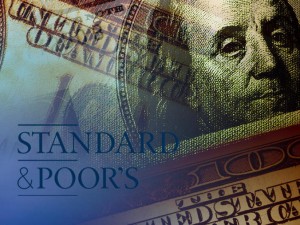by Deepa Venkatraghvan
[box] One of the major developments as far as the global economy was concerned in recent times, was the S&P downgrade of U.S.’ debt rating from AAA to AA+. While stock markets world over felt the effect, many questions have been plaguing the commoner’s mind. Deepa Venkatraghvan lists some of these questions and answers them in an easy-to-understand fashion.[/box] [box type=”bio”] Deepa Venkatraghvan is a Chartered Accountant. She is also the author of the CNBCTV18 Bestsellers ‘Everything you ever wanted to know about investing’ (which was later updated and released as, ‘Everything you wanted to know about investing in difficult times’) and ‘What your financial agent will tell you and why you shouldn’t listen’. Her latest book, ‘Step by step guide to start Investing’ was published in March 2011. [/box]Early August was a rather action-packed time as far as the U.S. markets were concerned. First the U.S. debt ceiling was raised, which was considered good news (at least compared to what could have happened). But soon after, the U.S. stock markets plunged 500 points in a single day, the biggest single day fall since the 2008 financial and credit crisis. That week ended with rating agency S&P downgrading the U.S. debt rating from the highest AAA to AA+; the first rating downgrade for the U.S. in its entire history. Now there are reports about the U.S. going into another recession, called a ‘double-dip’ recession. Meanwhile, in Europe, countries like Italy, Greece and Spain are seeing severe debt crisis.
At this point, here are some common questions people may have:
– Is this recession related to the 2008 crisis or is it another one?
– Are the crises in the U.S. and Europe related?
– Why is the downgrade such a big deal?
– Why is the dollar depreciating?
– Why should I care?
Let’s try to understand all of this.
Is this recession related to the 2008 crisis or another one?
Let’s revisit history.
2001 to 2008
We all know what happened in 2008. But here’s a quick recap anyway. Between 2001 and 2005, a bubble was being formed in the U.S. housing market with real estate prices going up rapidly. Banks too started lending aggressively to the housing market and in doing that they created what is now famous as the ‘sub-prime’ industry. Sub-prime lending refers to lending to people who may not be eligible for a loan under normal circumstances. Maybe they don’t have a regular job or income, or have defaulted in the past. Banks traditionally did not lend to such people due to high risk of default. But since these loans were mortgaged against property and property prices were rising continuously, banks began lending loans to this high-risk category. If customers defaulted, they thought they could sell the mortgaged property.
 However, banks did not factor in the possibility of a fall in property prices. When the Federal Bank (the U.S. equivalent of the RBI) started increasing interest rates, the sub-prime borrowers who couldn’t afford higher EMIs started defaulting and therefore, banks started selling off the mortgaged properties. The more properties that got sold, the faster property rates started falling.
However, banks did not factor in the possibility of a fall in property prices. When the Federal Bank (the U.S. equivalent of the RBI) started increasing interest rates, the sub-prime borrowers who couldn’t afford higher EMIs started defaulting and therefore, banks started selling off the mortgaged properties. The more properties that got sold, the faster property rates started falling.
Now these banks faced another problem, another animal. Between 2001 and 2005, the U.S. financial markets had developed a new product – a bond securitised against the mortgages. In simple terms, it means that the mortgage banks borrowed money against the mortgages on the condition that they would repay lenders as soon as they recovered their mortgages. The lenders in this case were financial institutions (like Bear Stearns, Lehman and Merril Lynch) who in turn sold retail bonds to individuals. These instruments were given credible rating by the leading credit agencies too. Sub-prime mortgages got bundled with Mortgage-Backed Securities (MBS) and Collateralised Debt Obligations (CDO) securities which got high ratings from credit rating agencies. High ratings were believed justified by various credit enhancements including over-collateralisation (pledging collateral in excess of debt issued), credit default insurance and equity investors willing to bear the first losses. Moreover, competitive pressure among rating agencies also led to lower credit rating standards. Whether these rating agencies will be chastised is not very clear – but maybe the regulatory grip over these agencies will tighten going forward. Sadly, the repayment never happened. And institutions like Bear Stearns, Lehman, Merrill Lynch and AIG were the casualties. Since the mortgages were not honoured, the banks could not repay these financial institutions who in turn could not repay retail investors.
This was happening across Europe too, particularly with those who were holding these bad bonds. This was what caused the crisis of 2008.
Banks are the financial backbone of an economy and a run on a bank is like a run on an economy. And we are talking hundreds of banks here.
2008-2010
In order to prevent a run on the large banks, the U.S. Government started to bail out the failed financial institutions to avoid them going bankrupt. They decided to dole out funds to these banks (the large ones) to the extent of loss they faced. The important question: Where did they get the money from? As it is, the people in the country were in bad shape. People were sitting on houses worth far less than their mortgages. They had accumulated huge debts with little savings. People stopped spending and unfortunately in the U.S., when people stop spending, the companies (dominated by processed and fast food, car makers and petrol companies, retail) stop making money and send the economy into recession. Jobs were starting to go. At this point, the Government could not raise money from taxes. In fact, it had to cut taxes. Moreover, the country had fought two expensive wars which had dipped heavily into Government surplus. The amount for bailout required was so huge that borrowing from other countries would have been expensive.
So the Fed decided to ‘print’ money to dole out in fiscal packages, called stimulus packages, running into trillions of U.S. dollars. Failing companies were given money to survive; people were given money to spend. There is usually a fear that printing money causes inflation but that didn’t happen with the U.S. in this case because firstly demand was low and secondly costs were kept low in the U.S. by cheap purchases from countries like China. The crisis, therefore, was temporarily controlled.
During this time, smaller countries in Europe started facing trouble as their banks held a lot of the bad mortgage-backed securities. Iceland went bankrupt. Ireland and Greece were running out of money.
2011
But the doling out of money was just a temporary solution. It only prevented a further fall. It only prevented the loss of more jobs. In the long-term, in order to keep the economy sustainable, in order to reduce the deficit (the gap between Government spending and earning) the U.S. had to do something to create jobs within the country, to promote sectors that created these jobs. And that of course is something that will take time, especially with emerging countries like China and India becoming strong hubs of manufacturing, service and job creation. The fiscal stimulus did not help promote industry, did not help create jobs. All this while, while the U.S. Government did not earn much by way of income, it still had the same level of spending to do to keep up the people’s standard of living. This led to a widening deficit. So in reality, the U.S. never recovered from the blow of 2008.
In this context, it’s usual to explain what a double dip recession is. A double dip recession occurs when an economy has a recession, and then emerges from the recession with a short period of growth, but quickly falls back into recession again. This is what everyone fears will happen in the U.S. now.
And now the next question.
Are the crises in Europe and US related?
Yes. As we saw earlier, the credit crisis of 2008 had spread to Europe where many banks were holding the bad assets of U.S. banks. As a result, economies of many smaller European countries started going down. Now, even the bigger economies like Portugal, Italy and Spain are feeling the heat. The problem across is universal: too much Government spending compared to too little Government earnings. While Euro is the uniting currency of many European nations, fiscal discipline of constituent countries was lacking.
If the European countries and people start spending less, this will impact the U.S. economy. This is because the U.S. exports a lot of things like software, video games and all kinds of intellectual property to Europe.
Now, let’s see why the debt downgrade by S&P is being discussed so widely.
Why is the U.S. debt downgrade such a big issue?
How did the U.S. Government fund the widening deficit? It borrowed more. It borrowed so much that it hit the debt ceiling. The debt ceiling is a self-imposed limit for U.S. Government borrowing. Increasing the debt ceiling was by itself not a difficult task because it was up to the Government to decide. But increasing the debt ceiling would send a signal to the rest of the world about a weakening U.S. economy. So far, the U.S economy and therefore the U.S. dollar were the strongest in the world. The U.S. Government had a great credit rating (AAA) and hence, it could raise money from other countries at very low interest rates. Raising the debt ceiling would hamper its credit worthiness. S&P downgraded the US long-term debt to AA+. This would mean higher borrowing costs for the U.S. which in turn will affect the deficit or result in slow growth.
Why is the dollar depreciating? Will this depreciation continue?
The currency is a reflection of the strength of an economy. It shows the credit worthiness of the country. If I hold dollars, it means that I believe I will always be able to sell it at a certain price. There will always be a buyer for my dollar. I will invest in U.S. treasury bonds because I believe the U.S. will never default. I will always get my money back. The dollar has been, for the longest time, the strongest currency in the world. But the crisis over the last few years has shaken that confidence. People have been selling dollars that they hold and buying gold (that is why gold prices are going up). People believe they will no longer get what they expect from the dollar. When people, institutions, and countries start selling dollars in the open market, there is an excess supply of dollars. This brings down the value of the dollar. For now, the US dollar is set to reign supreme despite inherent weaknesses, as there obviously is no other alternative currency to de-throne it as universal currency. Such supremacy flows from a) dollar penetration into global economy, b) high percentage of global reserve being held in dollar and c) U.S. thriving on its Current Account deficit (imports running higher than its exports).
always be able to sell it at a certain price. There will always be a buyer for my dollar. I will invest in U.S. treasury bonds because I believe the U.S. will never default. I will always get my money back. The dollar has been, for the longest time, the strongest currency in the world. But the crisis over the last few years has shaken that confidence. People have been selling dollars that they hold and buying gold (that is why gold prices are going up). People believe they will no longer get what they expect from the dollar. When people, institutions, and countries start selling dollars in the open market, there is an excess supply of dollars. This brings down the value of the dollar. For now, the US dollar is set to reign supreme despite inherent weaknesses, as there obviously is no other alternative currency to de-throne it as universal currency. Such supremacy flows from a) dollar penetration into global economy, b) high percentage of global reserve being held in dollar and c) U.S. thriving on its Current Account deficit (imports running higher than its exports).
Why should I care?
It’s important to understand all these things not only to improve knowledge but also to be prepared. A U.S. crisis is likely to impact India too; our IT exports will be affected. Foreign investments that we need for our infrastructure development will come down. While our domestic economy is strong and India has a large consumption base, we will still see some slowdown in growth.
(with additional inputs from Viswanathan Subramanian)
If you have any queries, drop a comment below and the author will be happy to answer your questions.
[button link=” https://sparkthemagazine.com/wp-content/uploads/2011/09/Spark-Sep2011.pdf” color=”red” newwindow=”yes”] Click here to download the September 2011 issue as a PDF.[/button] [button link=”http://issuu.com/sparkeditor/docs/spark-sep2011?mode=embed&layout=http%3A%2F%2Fskin.issuu.com%2Fv%2Fcolor%2Flayout.xml&backgroundColor=000000&showFlipBtn=true” color=”green” newwindow=”yes”] Click here to flip and read the issue like a magazine.[/button]
[facebook]share[/facebook] [retweet]tweet[/retweet]












[…] THE U.S. DEBT DOWNGRADE – WHAT DOES IT MEAN TO US? BY DEEPA VENKATRAGHVAN […]